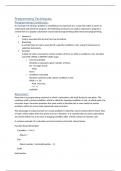Summary
Summary Problem Solving and Programming
- Institution
- OCR
This document can summarize the unit 2.2 in computer Science, which covers: Programming techniques Constructs Recursion Variables Integrated Development Environment Object Oriented Techniques Computational Methods
[Show more]



